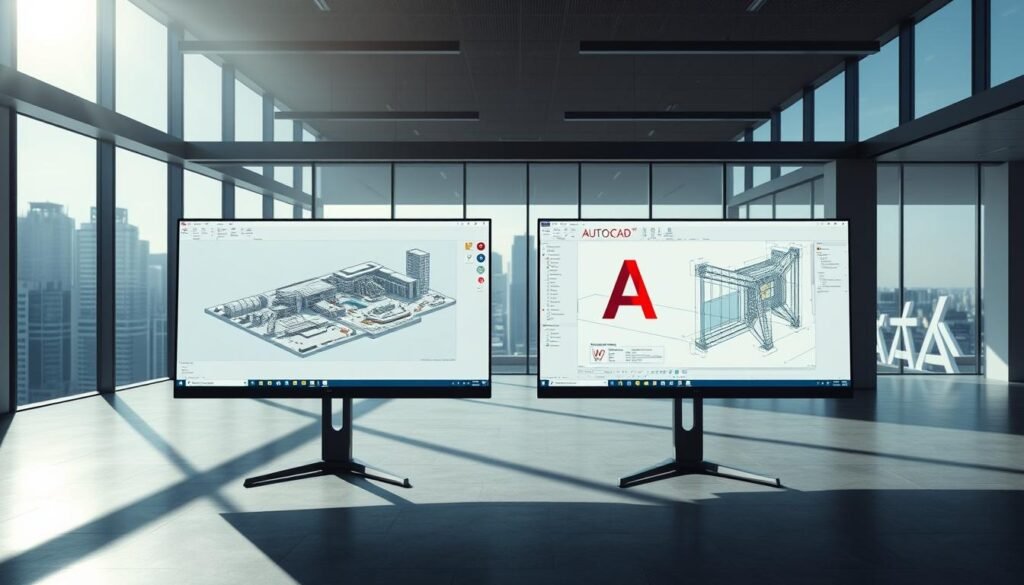The architectural landscape is continually evolving, and the choice of software plays a crucial role in shaping the designs of tomorrow. As we approach 2025, architects and designers are faced with a critical decision: whether to use Revit or AutoCAD for their projects.
Both Revit and AutoCAD are industry-standard tools, but they serve different purposes. Revit is known for its Building Information Modeling (BIM) capabilities, allowing for complex data-rich models, while AutoCAD is a computer-aided design (CAD) software ideal for detailed drafting and documentation.
Choosing the right software is vital for architects to efficiently plan, design, and execute their projects. The comparison between Revit and AutoCAD will help professionals make an informed decision based on their specific needs and project requirements.
Key Takeaways
- Understanding the fundamental differences between Revit and AutoCAD is crucial for architects.
- The choice between Revit and AutoCAD depends on the specific needs of the project.
- Revit’s BIM capabilities offer advanced features for complex modeling.
- AutoCAD is ideal for detailed drafting and documentation.
- The right software choice can significantly impact project efficiency and execution.
The Current State of Architectural Software in 2025
The current state of architectural software in 2025 highlights the growing importance of building information modeling (BIM) and computer-aided design (CAD). The industry has witnessed significant advancements in software technology, with Autodesk’s AutoCAD and Revit leading the way.
As architectural projects become increasingly complex, the need for sophisticated design tools has never been more pressing. Both AutoCAD and Revit have evolved to meet these demands, offering enhanced features that streamline the design process.
How AutoCAD Has Evolved for Modern Architecture
AutoCAD has continued to adapt to the changing needs of architects, incorporating advanced features such as improved 2D drafting and 3D modeling capabilities. Its latest version includes enhanced annotation and documentation tools, making it easier to produce detailed drawings and reports.
Revit’s Position as the Leading BIM Platform
Revit remains the industry standard for BIM, offering a comprehensive platform for architectural design, documentation, and collaboration. Its ability to integrate data from various sources and facilitate coordination among stakeholders has solidified its position as a leading BIM solution.
The Indian Architectural Software Market
The Indian architectural software market is experiencing rapid growth, driven by government initiatives and a booming construction sector. The demand for advanced design software like AutoCAD and Revit is on the rise, with many Indian firms adopting BIM to improve project efficiency.

| Software | Key Features | Market Presence |
|---|---|---|
| AutoCAD | 2D drafting, 3D modeling, annotation tools | Global, widely used in India |
| Revit | BIM, design documentation, collaboration tools | Global, increasingly adopted in India |
Revit vs AutoCAD 2025: Core Features Comparison
With the advancement in architectural software, Revit and AutoCAD have developed distinct capabilities in 3D modeling, parametric design, and collaboration tools in 2025. This section provides an in-depth comparison of their core features to help architectural professionals make informed decisions.
3D Modeling and Design Capabilities
Both Revit and AutoCAD have robust 3D modeling capabilities, but they differ in their approach. Revit is built around Building Information Modeling (BIM), which allows for more complex and intelligent 3D models.
Parametric Design Features
Revit’s parametric design capabilities enable architects to create adaptive components and manage complex relationships between building elements more effectively. AutoCAD also offers parametric design tools, but they are not as sophisticated as Revit’s.
Visualization Tools
AutoCAD provides advanced visualization tools, including realistic rendering and animation capabilities. Revit also offers visualization features, particularly when integrated with other Autodesk tools like Enscape or Lumion.

Documentation and Drawing Production
The efficiency of documentation and drawing production is crucial for architectural projects. Both software tools have features that cater to these needs, but with different strengths.
2D Drafting Efficiency
AutoCAD remains superior in 2D drafting efficiency, offering a wide range of tools for creating detailed drawings quickly. Its interface is highly customizable, which can significantly speed up the drafting process.
Construction Documentation
Revit excels in construction documentation due to its BIM capabilities. It can automatically generate documentation that is consistent with the 3D model, reducing errors and improving productivity.
Collaboration and Data Management
Collaboration is a critical aspect of architectural projects. Both Revit and AutoCAD offer features that facilitate collaboration, but they differ in their approach.
Cloud Integration
Revit and AutoCAD both offer cloud integration through Autodesk’s cloud services, enabling real-time collaboration and data sharing. However, Revit’s BIM data is more effectively managed in a collaborative environment.
Team Workflows
Revit’s team workflows are designed around its BIM capabilities, allowing for more streamlined collaboration on complex projects. AutoCAD also supports team workflows, particularly through its integration with other Autodesk tools.
In conclusion, the choice between Revit and AutoCAD in 2025 depends on the specific needs of the architectural project, including the type of project, the complexity of the design, and the collaboration requirements.
Workflow Efficiency for Architectural Projects
The workflow efficiency of architectural projects is a critical factor that distinguishes successful firms, with Revit and AutoCAD offering different approaches. Workflow efficiency encompasses various aspects, including design development, project coordination, and client presentation. Understanding how each software impacts these areas is crucial for architectural firms in India looking to optimize their workflows.
Design Development Process Comparison
The design development process is a fundamental aspect of architectural projects. Revit, with its Building Information Modeling (BIM) capabilities, allows for a more integrated and data-rich design process. This enables architects to create detailed building models that include both geometric and non-geometric data, facilitating better decision-making throughout the project lifecycle.
AutoCAD, on the other hand, is a Computer-Aided Design (CAD) software that excels in producing precise 2D drawings and 3D models. While it is highly versatile and widely used, its lack of inherent BIM capabilities means that it may not offer the same level of data integration as Revit. However, AutoCAD’s flexibility and customization options make it a valuable tool for specific design tasks.
| Feature | Revit | AutoCAD |
|---|---|---|
| Design Approach | BIM-centric, data-rich models | CAD-centric, precise 2D/3D drawings |
| Data Integration | High, with parametric modeling | Moderate, with some data capabilities |
| Customization | Moderate, with Revit API | High, with extensive customization options |
Project Coordination and Management
Project coordination and management are critical to the success of architectural projects. Revit excels in this area due to its BIM capabilities, which enable real-time collaboration and data sharing among project stakeholders. The software’s ability to detect clashes and inconsistencies in the model helps reduce errors and improve overall project quality.
AutoCAD also offers tools for project coordination, particularly through its collaboration features and integration with other Autodesk software. However, its lack of native BIM capabilities means that it may not be as effective as Revit for managing complex building projects.
Client Presentation and Visualization
Effective client presentation and visualization are essential for communicating design intent and securing project approvals. Both Revit and AutoCAD offer visualization tools, although Revit’s BIM models provide a more comprehensive basis for creating detailed and accurate visualizations. Revit’s integration with other Autodesk visualization tools, such as Lumion, further enhances its visualization capabilities.
AutoCAD’s visualization tools are also robust, particularly for 2D drawings and 3D models. However, the quality of visualizations may not be as high as those produced from Revit’s BIM models.
Cost Analysis and ROI for Indian Architectural Firms
As Indian architectural firms weigh their options between Revit and AutoCAD in 2025, a comprehensive cost analysis becomes crucial. The decision between these two software giants involves not only the initial licensing costs but also ongoing expenses, training requirements, and potential return on investment (ROI).
Licensing and Subscription Models in 2025
In 2025, both Revit and AutoCAD offer flexible licensing and subscription models tailored to the needs of architectural firms. Autodesk, the company behind both software products, has shifted towards a subscription-based model, offering various plans, including monthly and annual subscriptions. This shift allows firms to manage their cash flow more effectively. For instance, Autodesk offers a Flex model that provides flexibility in purchasing and managing software access. Indian firms can benefit from this flexibility by scaling their software usage according to project demands.
Training Requirements and Learning Curve
The training requirements and learning curve for Revit and AutoCAD can significantly impact the overall cost for architectural firms. Revit, being a BIM (Building Information Modeling) tool, generally requires more extensive training due to its complex functionalities and data management capabilities. AutoCAD, on the other hand, is more familiar to many professionals, potentially reducing the training time and costs. Firms should consider the time-to-productivity when evaluating these software options.
Long-term Investment Considerations
When evaluating Revit and AutoCAD, Indian architectural firms must consider the long-term investment implications. This includes not only the direct costs like licensing and training but also indirect costs such as the potential impact on project timelines and the quality of deliverables. A thorough ROI analysis should factor in the software’s ability to enhance collaboration, improve design accuracy, and streamline documentation processes. By doing so, firms can make an informed decision that aligns with their strategic goals and financial constraints.
Which Software Suits Different Architectural Scenarios?
Different architectural scenarios demand different software solutions, making it vital to understand where AutoCAD and Revit excel. The choice between these tools largely depends on the project’s specific requirements, the type of design work involved, and the desired outcomes.
Best Use Cases for AutoCAD in 2025
AutoCAD remains the preferred choice for projects that require detailed 2D drafting and documentation. Its capabilities make it ideal for:
- Projects involving extensive 2D drawings and annotations
- Design tasks that require high precision and control
- Collaborations where partners or clients primarily use AutoCAD
AutoCAD’s strengths in 2D design and its compatibility with various file formats make it a versatile tool for a wide range of architectural tasks.
Best Use Cases for Revit in 2025
Revit is tailored for Building Information Modeling (BIM) and is best suited for projects that benefit from its advanced 3D modeling and data management capabilities. Ideal scenarios include:
- Complex building designs that require detailed BIM data
- Projects where collaboration and data sharing among multiple stakeholders are critical
- Designs that need to be analyzed for energy efficiency, structural integrity, and other performance metrics
Revit’s capabilities in managing complex building models and providing insights through analysis tools make it indispensable for modern architectural practices.
Hybrid Workflows: Combining CAD and BIM
In many cases, architectural firms can benefit from using both AutoCAD and Revit in hybrid workflows. This approach allows them to leverage the strengths of each software:
| Task | Software | Benefit |
|---|---|---|
| 2D Drafting | AutoCAD | Precision and control in 2D drawings |
| BIM Modeling | Revit | Advanced 3D modeling and data analysis |
| Collaboration | Both | Flexibility to work with different stakeholders’ preferred software |
By adopting a hybrid workflow, firms can optimize their design processes, improve collaboration, and enhance overall project efficiency.
Conclusion: Making the Right Choice for Your Architectural Practice
Choosing the right software is crucial for the success of an architectural practice. The Revit vs AutoCAD decision depends on several factors, including project complexity, collaboration requirements, and the need for detailed documentation.
For Indian architectural firms, the choice between Revit and AutoCAD ultimately depends on the specific needs of their projects. Revit is ideal for projects that require complex 3D modeling and Building Information Modeling (BIM), while AutoCAD remains a versatile tool for 2D drafting and detailed drawing production.
When making the Revit vs AutoCAD decision, consider the long-term benefits of each software, including cost analysis, training requirements, and potential return on investment. By understanding the strengths and limitations of each tool, architectural practices can optimize their workflows and improve project outcomes.
By carefully evaluating the core features, workflow efficiency, and cost considerations of Revit and AutoCAD, architectural firms in India can make an informed decision that aligns with their business goals and enhances their overall productivity.

